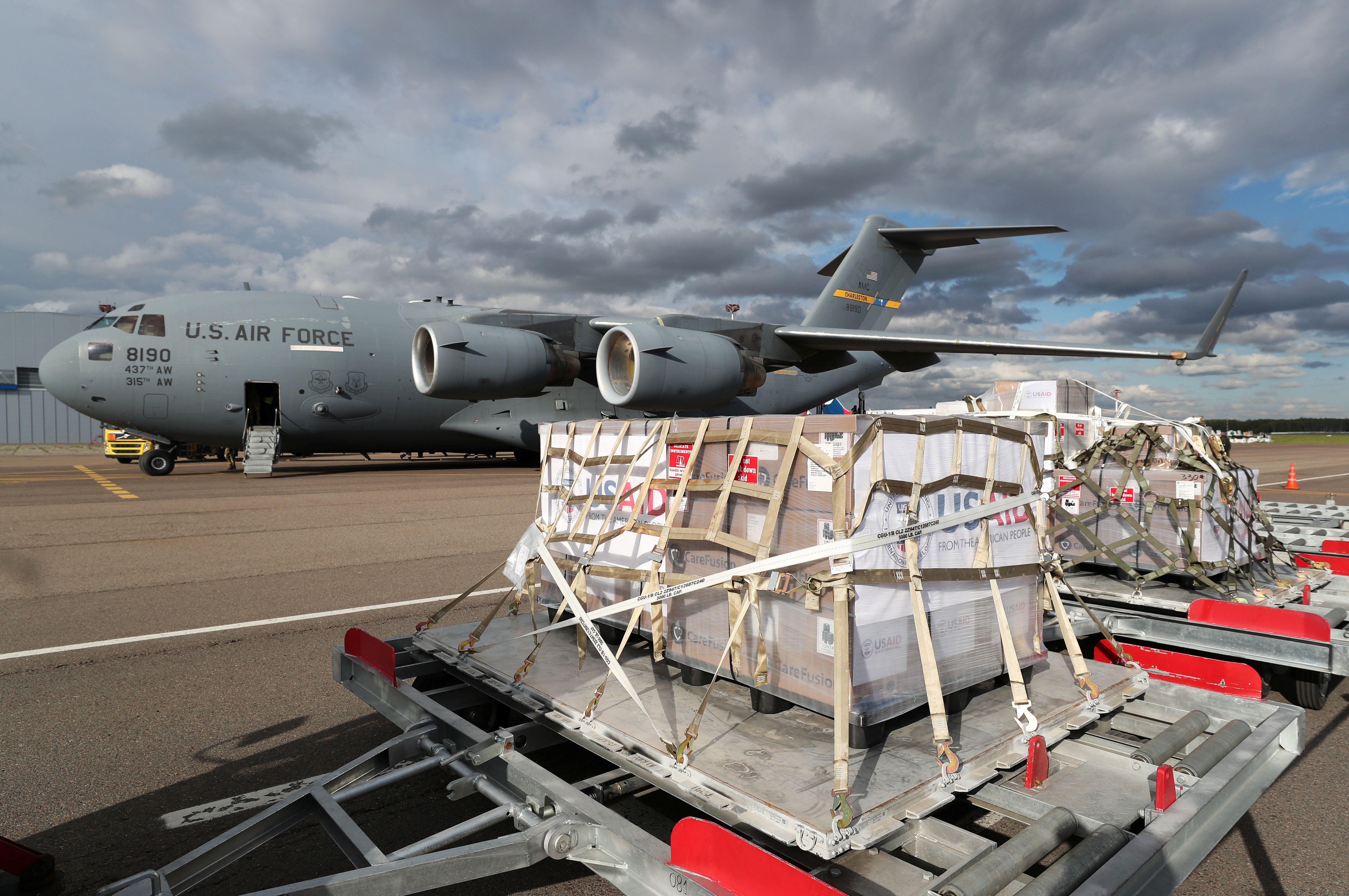NATO and the Coronavirus: Navigating Unchartered Waters

In the initial days of the pandemic, NATO focused on maintaining the ability to perform its day-to-day business. The Alliance implemented measures to limit the threat of infection to soldiers and civilians engaged in Alliance missions and working in its structures. As collective defence remains its core mission, NATO’s natural instinct was to underline in the very early days of the pandemic that the crisis would not diminish the Alliance’s ability to fulfil its tasks. At the same time, its adversaries did not stop probing and testing Allied readiness. For example, Russia continued strategic bomber flights and maritime manoeuvres close to NATO borders.[1]
Getting a Grip on the Coronavirus Challenge
While NATO successfully signalled its readiness to implement its core mission, in the initial period of the pandemic the allies failed to fully use the Alliance’s political mechanisms to consult national responses to the emerging crisis. For example, Italy did not receive medical help it requested from Germany and France. President Donald Trump announced the U.S. would close its borders to travellers from the Schengen area without consulting America’s European allies. Russia and China unexpectedly offered medical equipment and personnel, which was shipped to Italy, exploiting the initial lack of coordination and solidarity between the Allies to the benefit of Russian and Chinese propaganda. NATO was also slow to respond to the Chinese and Russian disinformation, which included allegations that the virus originated in the West, and the Alliance itself was accused of spreading the virus across European states where member state military personnel were deployed.
The turning point came with the North Atlantic Council (NAC) meeting at the level of foreign ministers on 2 April 2020.[2] Since then, NATO has begun more effectively and with more visibility to use various tools at its disposal, both to demonstrate its practical support for the allies in fighting the pandemic and to contest COVID-19-related propaganda. The Euro-Atlantic Disaster Response Coordination Centre (EADRCC) was put at the forefront of the effort. Established in 1998, EADRCC has a clearing-house function and facilitates the coordination of requests for help and offers of assistance. From April onwards, it has been used more extensively to ship voluntary medical assistance, mainly personal protective equipment and respirators, donated by allies less affected by the pandemic to those that are hardest hit, like Italy or Spain, and also to NATO partners. The NATO Support and Procurement Agency (NSPA) has provided logistics support, organised transport of supplies, and coordinated procurement of medical equipment. Also, the allies have used strategic transport capabilities managed by NATO, such as the Strategic Airlift Command (SAC) or the SALIS mechanism, to import and distribute medical help or transport patients. NATO’s Rapid Air Mobility Initiative enabled simplified procedures for emergency flights and faster deliveries.
|
Requests for assistance through the EADRCC: NATO Allies |
Spain, Montenegro, Italy, Albania, Slovenia, Bulgaria, North Macedonia
|
|
Requests for assistance through the EADRCC: NATO partners |
Ukraine, Moldova, Bosnia and Herzegovina, Georgia, Colombia, Afghanistan, Mongolia, Tunisia, Iraq + the UN Office for the Coordination of Humanitarian Affairs (UN OCHA) |
|
Scope of military-delivered assistance (national, NATO-coordinated) |
- about 350 transport flights of medical personnel; - more than 1,000 tonnes of medical equipment delivered; - assistance in construction of about 100 field hospitals. |
Data as of June 2020; sources: https://www.nato.int/cps/en/natohq/news_174854.htm?; https://www.nato.int/nato_static_fl2014/assets/pdf/2020/5/pdf/200525-factsheet-COVID-19_en.pdf.
Equally importantly, NATO began to prepare for the expected second wave of the pandemic. These planning efforts resulted in the 18 June decision by NATO defence ministers to establish a stockpile of medical equipment and supplies together with a dedicated common fund that would cover the costs of quickly acquiring medical equipment and services to augment the healthcare systems of allies if the pandemic strikes again. The fund is expected to become operational in the autumn when allies start to donate money to the pool, hence its final size is still uncertain.[3] Through these actions, NATO may not only be better prepared for the next peak of infections, but also limit the risk that the public in NATO countries would perceive it as irrelevant actor, unable to respond to COVID-19 crisis.
The pandemic also affected to some extent the credibility of NATO defence and deterrence, contrary to initial declarations of maintaining the course. The most visible aspect was the scaling down or cancellation of a number of military exercises. The U.S. limited the scale of the Defender Europe 2020 manoeuvres—planned as the largest deployment of U.S.-based forces to Europe in more than 25 years. Instead of the deployment of a reinforced division-size force with 20,000 troops, only 6,000 were deployed to Europe (modified Defender exercises were still held, albeit in a scaled-down format). The U.S. European Command (EUCOM) has called off a number of exercises, which were coordinated with the Defender: Joint Warfighting Assessment, Dynamic Front, Saber Strike, and Swift Response. Other important exercises were also affected. Norway cancelled the Cold Response manoeuvres. The UK reduced the scale of Joint Warrior exercises, which involved submarine operations in the North Sea, which were meant to better prepare its navy to address the increasing Russian maritime activity in the region.
Although some cases of infections were reported among the personnel of multinational battle groups deployed on the Eastern Flank through the Enhanced Forward Presence (EFP) mechanism, the ability of these units to fulfil their tasks remained largely intact. Also, Baltic Air Policing continued as scheduled, with Spain—severely hit by the pandemic—providing the leading nation role from 1 May. Other NATO missions, however, were more affected by the pandemic. The training mission in Iraq (NMI) was suspended in January because of increased threats to NATO personnel. Shortly afterwards, some allies began to pull back troops from this operation because of COVID-19. France withdrew about 200 soldiers in March and Canada around 400 soldiers in April. The chances that NMI will be back on track quickly are, hence, low.[4]
The Looming Economic Crisis and Challenges to Cohesion
Between now and the end of 2021, the pandemic will pose even more challenges to NATO political cohesion and the credibility of its deterrence and defence potential. Leaving aside the threat of the second wave, these challenges will be mostly the result of economic crisis, which will start to affect defence expenditures of allies, and the changing threat perception across the Euro-Atlantic area, which is likely to further increase tensions over the optimal balance between NATO tasks.
Some allies may have to revise their defence spending already in 2020, and it is almost certain in 2021. Given the recession, it will be hard for many governments to maintain the growth of defence expenditures and some may even cut them. This may reduce investments in new capabilities and involvement in NATO operations and exercises.
The biggest NATO countries will most likely continue their deployments in NATO battlegroups on the Eastern Flank (EFP) as long as the consensus on deterrence policy towards Russia holds. Contributions of troops to the NATO Response Force (NRF) seem safe from the cuts, mostly owing to the fact that requirements for this pool of forces has been known for a while and the allies have included it in their long-term planning. However, the development of bigger follow-on forces, especially under the novel NATO Readiness Initiative (NRI, or “Four 30s”, confirmed at the December 2019 summit in London), could become a major challenge. Some of the committed forces (30 armoured or mechanised battalions, 30 combat air squadrons, and 30 major naval combatants, ready to be used within 30 days) are yet to be modernised, re-equipped, and undergo a full exercise cycle. NATO also still needs to complete changes to its command structure. The new Joint Support and Enabling Command (JSEC, responsible for logistics throughout Europe) in Germany, and Joint Force Command in Norfolk in the United States (responsible for operations in the North Atlantic), are in the process of achieving full operational capability. Cuts in investments, exercises, and slower development of infrastructure could limit the chances that additional NATO units become operational and deployable.
The cuts may also damage NATO political cohesion. The gravity of this issue was highlighted by the Trump administration’s June announcement that the U.S. would reduce troops stationed in Germany. NATO risks further intensification of transatlantic disputes on burden-sharing, irrespective of who wins the presidential election in the U.S. While the recession will in all probability affect all NATO members, the U.S. will still expect European Allies to take greater responsibility for security in Europe and its neighbourhood.
The pandemic also could bring a major change in threat perception in societies across the Alliance. Political and military threats, especially those posed by Russia, are likely to become less important than non-military threats. Public opinion may become primarily concerned with the pandemic and its effects, irregular migration, organised crime, climate change, economic insecurity, and asymmetric threats, especially terrorism and cyberattacks. This, in turn, could prompt demands that NATO enhance its non-military crisis-management tools and focus more on strengthening the resilience of Allied countries and societies against threats that do not have a clear military dimension. Such adaptation, while to some extent justifiable, may also draw attention and resources away from traditional threats and weaken NATO’s determination to implement its deterrence and defence policy.
Actions along these lines and defence spending cuts would likely be accompanied by pressure within NATO for détente in relations with Russia. Some Allies might seek a return to practical NATO-Russia cooperation (especially in countering pandemics, terrorism, and other non-military threats), limit support to Ukraine, or, in a far-reaching scenario, advocate the suspension of NATO’s open-door policy. The demand for new arms-control arrangements would grow as well. All these potential initiatives run the risk of exacerbating tensions in the Alliance over its strategy towards Russia. Nations that feel an acute threat from Russia are simply unlikely to accept halting, weakening, or winding back the adaptation of NATO to effectively deter and defend Eastern Flank, regardless of COVID-19.
Policy towards China is another potential source of tensions within the Alliance. One of the key effects of the pandemic on the strategic level is likely to be much greater U.S. pressure on limiting China’s investments in European critical infrastructure, including, but not limited to 5G networks, and in other sectors. Although the approaches by the allies on both sides of the Atlantic to China are gradually converging, in conditions of austerity some rifts may deepen while others may reappear. This can particularly be the case if the U.S. pushes its European allies to decouple from China, a concept they might perceive as detrimental to their economic recovery. There have already been suggestions that the EU should develop autonomous policy to China, not necessarily in synch with American goals and interests.[5] The deeper the economic crisis and changes in threat perceptions among European publics, and the more successful Chinese propaganda and disinformation is, the more likely such developments will occur.
As the pandemic is only beginning to take its toll in many areas of the globe and the second wave is already rising in some regions, it can’t be excluded that at some point it will lead to unexpected security crises. The main threat for NATO lies in a scenario in which deep economic and political turbulence following a particularly serious local outbreak of COVID-19 lead to a state collapse, an escalation of regional tensions or even an outbreak of an armed conflict. An intentional escalation may be used, particularly by autocratic regimes, to consolidate society around the government and assure regime survival. The Alliance should not aim to react to any crisis in the world. Some crisis scenarios might not involve NATO at all. However, any major escalation in or around the Eastern or Southern flanks of NATO would likely require a political, and potentially also a military, response, as allies’ security might be seriously compromised.
Adapting to the Post-Pandemic Security Environment
Beyond 2021, the economic crisis may start to have a structural impact on the allies’ budgets and military capabilities. Over time, austerity may increase the technological gap and reduce interoperability between NATO countries, which is crucial both for collective defence and crisis-management missions. This would be the result of halt to, delays or scaling down national investments into new capabilities deemed non-essential or too expensive in the new circumstances. What may be particularly affected are high-readiness forces, heavy capabilities, and the most expensive weapon systems (e.g., naval and air platforms).
This will also harm the relative and regional force balance between NATO and some of its potential adversaries. Sustaining the pool of forces and the set of capabilities to meet NATO’s pre-pandemic “Level of Ambitions” with regards to operations will be increasingly difficult. The Alliance may be forced to consider modifying its planning assumptions and goals, as well as adapt its doctrine. There could be even some discussion whether the weakening of conventional forces could be compensated by an increased role for nuclear weapons. The likely increase of funds devoted to boosting resilience against non-military threats at the expense of military capabilities will further affect the deterrence and defence potential of the Alliance.
NATO’s long-term future will also depend on how the defence-related cooperation in the EU and of the European “coalition of the willing” formats will be linked with the Alliance and positioned in the broader context of the transatlantic bond. In response to the post-pandemic situation, and to transatlantic tensions if they keep increasing, major EU countries (France, Germany, Italy, Spain) may be tempted to move ahead with new, more ambitious projects of European integration, implementing the concept of European strategic autonomy by either strengthening the EU’s defence portfolio or developing new cooperation vehicles outside the Union.
In the political dimension, strengthened European strategic autonomy may manifest itself in the creation of a new coordination instrument excluding the U.S., for example, a European Security Council. In the operational domain, this would involve deepening inter-European military cooperation within the framework of the EU, the European Intervention Initiative, or bilateral formats. As regards the industrial dimension, it may involve preferences for European defence companies in military acquisitions and keeping the U.S. completely outside European defence cooperation initiatives like PESCO. If such a policy is pursued—and presented as an alternative to the U.S. and NATO security guarantees—a serious crisis within the Alliance may emerge and weaken both its cohesion and the credibility of its defence and deterrence.
With such trends, the U.S. commitment to European security may easily dwindle. The withdrawal of the U.S. from NATO seems unlikely, given the pro-Atlanticist views of the majority of Americans, Congress, and the administration. Still, the pandemic will force the U.S. to focus attention inwards to address the political, social, and economic challenges of the recovery. While this will not necessarily mean a retreat from its preeminent role in global security or from its alliance obligations, the U.S. will likely decrease its direct military engagement worldwide and put even more focus than now on addressing direct threats to its security, rather than those challenging Europe. This will happen regardless of the result of the November presidential elections.
As a consequence, the U.S. will further intensify the pressure on its NATO allies to take up the financial and operational burden of maintaining security in the Euro-Atlantic area. If not met with a constructive reaction of European allies, this pressure may end up with gradual limitation of the U.S. role in providing security for Europe. This may take the form of a reduction of American forces deployed to Europe. While Trump’s June 2020 announcement that the U.S. would downsize its forces in Germany to punish the country for underspending on defence is opposed by Congress and part of the security establishment, American attitudes could change. The combination of increased post-pandemic budgetary pressure in the U.S., likely cuts in European defence spending, and growing demand for U.S. engagement in the Asia-Pacific region would risk undermining the current bipartisan consensus on the need to maintain and strengthen U.S. military capabilities in Europe. These factors could cause a policy turn also under a Biden presidency, even though he pledged to reinvigorate NATO and U.S. leadership in the Alliance.
The pandemic also will affect the Alliance’s adversaries. Even if it does not result in any unexpected security crisis, it will strengthen some states and weaken others, which will have consequences for the U.S. and NATO. For example, China may further improve its relative position vis-à-vis the U.S. and its Asian allies, and can pursue more aggressive policy in the Asia-Pacific region. This will, in turn, force the U.S. military to devote more resources towards containing China, which will influence American policy towards NATO. Depending on the scale and the social and economic consequences of the pandemic in Russia, its international position may be further weakened, especially if the public health crisis leads to political or social upheavals, or strengthened if it contains the spread of the disease and some of its regional adversaries are more seriously affected. Both scenarios would have serious implications for NATO. Some allies would most likely be concerned about the potential of more aggressive behaviour of a post-pandemic Russia, while others would argue that the change of circumstances justifies a policy review by NATO and “normalisation” of relations.
Towards Balancing the Old and New Agendas
The magnitude and consequences of the challenge NATO is now facing are yet to be fully comprehended. Economic and political fallout from the pandemic are very likely to exacerbate existing tensions and threats to NATO, while new challenges to Allied political cohesion and credibility of defence and deterrence are likely to grow. In response, NATO will be expected to consolidate and adapt. Like it did in the past with the tectonic shifts in the security environment (e.g., 1989, 2001), it must get its role in the new reality right.
As regards adaptation, the NATO 2030 Initiative could offer a vehicle for bringing the Alliance closer to this goal. Launched by the Secretary General in line with the decision of the allies made at the December 2019 summit in London, the initiative aims to conduct a “forward-looking reflection process […] to strengthen NATO’s political dimension”.[6] While not meant to directly lead to the next Strategic Concept, the NATO 2030 Initiative (involving also the work of a special expert group advising the Secretary General) may provide an excellent opportunity to stimulate the thinking of decision-makers and public opinion in NATO states about both the challenges to security and internal cohesion of the Alliance.[7]
The Alliance should accept that it will be expected to continue fulfilling its core tasks, albeit in conditions of a continued biological threat especially to the readiness and availability of forces. At the same time, other current threats are unlikely to disappear. In fact, Russia is very likely to continue its policy of revisionism and provocation, China will test the commitment of the U.S. and its allies, and terrorist organisations will try to expand and establish safe havens in Africa and the Middle East. The proliferation of weapons of mass destruction and cyberattacks may intensify. On top of that, NATO will be expected to contribute more to mitigating the pandemic, to building up the resilience of states and societies to non-military threats, and to shoring up its capacity to react to non-military crises in general. The effects of climate change, which may aggravate existing tensions and conflicts, are also likely to find an important place on the NATO agenda.
To address all these challenges, NATO must, above all, nurture political cohesion. Hence, the Alliance should continue to use its assets to help limit the effects of the pandemic, particularly against a second wave. Mutual assistance, provided by allies less affected for now to those hit the hardest, should be enabled through NATO. This aid should be accompanied by a timely and intensive strategic communication campaign presenting the role of the Alliance in providing such assistance and also aimed at debunking fake news regarding the origins and effects of the pandemic. By demonstrating practical utility in fighting the pandemic and making gestures of allied solidarity properly visible, NATO may prevent perceptions that its military focus means it is unable to address the most imminent security needs of its members’ population.
NATO may be required to play a bigger role in responding to non-military challenges to security and to building the resilience of states and societies. NATO should expand its role in these areas, but not at the expense of collective defence, which remains the main focus and binding force of the Alliance. Fighting non-military threats cannot become a priority for NATO. To find the proper balance, NATO may decide to perform only a coordinative and enabling function with regards to addressing novel threats (such as pandemics or climate change), while increasing its cooperation with the EU, which has a vast array of civilian crisis-management assets at its disposal. How to strike such an optimal balance may be one of subjects of the NATO expert group’s work. While at this point the 360-degree principle is only a potential source of tensions, the Alliance should explore a creative interpretation of it that involves threats like a pandemic.
The Alliance will not entirely avoid challenges to the credibility of its defence and deterrence. Due to the recession, the existing capability development plans may not be met and this will affect the viability of NATO’s current military strategy. To keep its defence and deterrence posture as close as possible to what has been agreed in 2014-2020, NATO needs to maintain the consensus on Russia in the first place. While it may be questioned by some allies, it relies on robust foundations: agreed NATO assessments of the threat posed by Russian capabilities deployed close to the borders of the Alliance, including its missile arsenal. Russia is signalling that its force posture will not change because of the pandemic and it has not dropped its revisionist policy towards its neighbourhood. Hence, NATO should aim to keep not only the EFP and the reformed NRF as agreed but also implement both the NRI and the reforms of the Allied Command Structure fully and in the agreed timeline while working on responses to the growing Russian missile threat.
At the same time, NATO should continue to explore the potential role of capabilities like long-range precision strike, cyber- and electronic warfare in deterring near-peer adversaries. This way, NATO may alleviate tensions over the costs of defence and deterrence. Simultaneously, NATO should continue to propose to Russia that it enter a substantial and reciprocal dialogue on military transparency, arms control, and disarmament while not dropping its principal stance on the issue of Russia’s illegal annexation of Crimea and Russian responsibility in sustaining the conflict in eastern Ukraine. While all ways of limiting the risk of involuntary escalation between Russia and NATO should be explored, the Alliance should acknowledge that demonstrating its commitment to fundamental rules of international law—primarily the inviolability of borders—reinforces its position as the cornerstone of the rules-based international order.
Another area in which the pandemic will likely take a heavy toll on NATO is defence budgets. Yet, NATO should stick to the 2014 Wales defence spending pledge because it is mobilising and highly symbolic. Abandoning it, either by declaration or by default will not serve well either the military capacity of the Alliance nor political cohesion. At the same time, it is worth considering postponing the original deadline for reaching the 2% of GDP goal to beyond 2024 and/or to reinvigorate the “three-Cs” formula (cash, capabilities, commitments), which was meant to introduce some sophistication to the metrics of allies’ contribution to the common security.
Sustaining the relevant level of defence expenditure across NATO is particularly important to the transatlantic bond, as—given the likelihood of budget cuts—the U.S. is poised to further ratchet up pressure on its European allies to take a bigger share in contributing to the common security of the transatlantic area. Yet, the Alliance should also strive to avoid tensions stemming from another potential contentious issues, mainly Europe’s pursuit of strategic autonomy. If the concept of European strategic autonomy is to be developed in a form in which it undermines NATO (politically, financially, operationally, etc.), the position of the Alliance as the pillar of peace and security in Europe may be questioned. This will enable adversaries of the Alliance to gain a new tool to drive a wedge between the U.S. and Europe and between European states themselves.
The negative scenario as regards the development of European strategic autonomy can be easily mitigated. Stronger European defence will reinforce NATO if it is developed in close coordination with the Alliance and not wrapped in anti-transatlantic rhetoric. The answer to the increasing political ambitions of the strongest European states that want to pursue European strategic autonomy may lie in the well-known idea of the European pillar in NATO. Exploring ways of implementing it in a changed strategic environment and through a further reinforced EU-NATO cooperation can offer a feasible way forward. Such a flexible approach on the part of both the EU and NATO might help balance the European drive to gain more autonomy from the U.S., mostly with regards to crucial military capabilities, and the imperative to keep NATO’s overall military capacity credible.
Finally, NATO will not avoid the challenge of defining its role more precisely in the context of security challenges stemming from Chinese policies. In the conditions of economic crisis, Chinese investments into European 5G networks and other infrastructure such as ports and railways may seem for some countries an attractive way to stimulate their economy. Given the U.S. calls to limit Europe’s dependency on China, tensions will likely mount. A way out might lie in agreeing at NATO a framework for assessing the security and defence consequences of Chinese investments in critical infrastructure in Europe so that commercial cooperation does not undermine the strategic interests of NATO. As has been discussed within the Alliance, NATO should have a global outlook, including on China, but not necessarily strive for global reach or, further, for a military presence.
[1]See for instance: C. McGrath, 'Unprecedented': Putin is testing British resolve during coronavirus crisis, warns expert, Daily Express, 4 April 2020 www.express.co.uk.
[2] Declaration by NATO Foreign Ministers issued following their meeting of 2nd April 2020, www.nato.int.
[3] Coronavirus response: NATO Defence Ministers plan for possible second wave of COVID-19, 18 June 2020, www.nato.in
[4] S. Frantzmann, “Have COVID-19 and Iran tensions doomed Coalition anti-ISIS strategy?” 1 May 2020, atlanticcouncil.org.
[5] “Europe’s ‘Sinatra doctrine’ on China,” The Economist, 11 June 2020, www.economist.com.
[6] London Declaration Issued by the Heads of State and Government participating in the meeting of the North Atlantic Council in London 3-4 December 2019, www.nato.int.
[7] “Secretary General launches NATO 2030 to make our strong Alliance even stronger,” NATO, 8 June 2020, www.nato.int.






